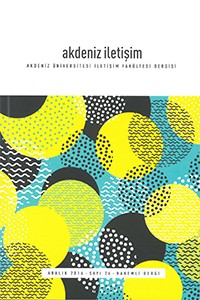First and Second Level Intermedia Agenda-Setting between International Newspapers and Twitter during the Coverage of the 266th Papal Election
Öz
effect occurs between the online versions of international newspapers and Twitter
during the Papal election in 2013. The researchers have tracked each available
country’s trending topics on Twitter to understand the popularity of the subject in various
countries. The researchers then followed each country available on Twitter at the time
when the study was conducted, starting right after the announcement of the new Pope
at the Sistine Chapel in Vatican on 12 March 2013 till 15 March 2013 for four days and
collected all available data. Later, the researchers collected data from the websites of
international newspapers, The New York Times, The Daily Mail, The Guardian, The
Telegraph and The Wall Street Journal. Two computer-based content analysis were
conducted. In order to understand the relationship amongst these media entities, the
cross-lagged panel design with the Rozelle-Campbell (1969) baseline was used. In the
end, researchers examined the second level agenda setting effect between media by
looking into what was said about the Papal election – positive, negative, or neutral. The
results supported both first and second-level agenda setting influence between media.
Anahtar Kelimeler
Agenda-setting Intermedia Agenda-Setting Papal Election Rozelle-Campbell Baseline International Newspapers Twitter
Kaynakça
- Besova, A. A., & Cooley, S. C. (2009). Foreign News and Public Opinion: Attribute AgendaSetting Theory Revisited. Ecquid Novi: African Journalism Studies, 30(2), 219–242. doi:10.3368/ ajs.30.2.219
- Bowe, B. J., Fahmy, S., & Wanta, W. (2013). Missing religion: Second level agenda setting and Islam in American newspapers. International Communication Gazette, 75(7), 636–652. doi:10.1177/1748048513482544
- Brown, C., Hendrickson, E., & Littau, J. (2014). New Opportunities For Diversity Twitter Journalists and Traditionally Underserved Communities. Journal of Social Media Studies, 1(1), 1–16. doi:10.15340/2147336611760
- Burns, J. W., Glenn, B., Bruehl, S., Harden, R. N., & Lofland, K. (2003). Cognitive factors influence outcome following multidisciplinary chronic pain treatment: a replication and extension of a cross-lagged panel analysis. Behaviour Research and Therapy, 41(10), 1163–1182. doi:10.1016/ s0005-7967(03)00029-9
- Camaj, L. (2014). Need for Orientation, Selective Exposure, and Attribute Agenda-Setting Effects. Mass Communication and Society, 17(5), 689–712. doi:10.1080/15205436.2013.835424
- Chaffee, S. H., & Schleuder, J. (1986). Measurement and Effects of Attention to Media News. Human Comm Res, 13(1), 76–107. doi:10.1111/j.1468-2958.1986.tb00096.x
- Chen, G. M. (2011). Tweet this: A uses and gratifications perspective on how active Twitter use gratifies a need to connect with others. Computers in Human Behavior, 27(2), 755–762. doi:10.1016/j.chb.2010.10.023
- Cohen, B. C. (1963). The press and foreign policy. Princeton, N. J: Princeton University Press.
- Coleman, R. & Banning, S. (2006). Network TV News’ Affective Framing of the Presidential Candidates: Evidence for a second-Level Agenda-Setting Effect through Visual Framing. Journalism & Mass Communication Quarterly, 83(2): 313-328. doi:10.1177/107769900608300206
- Conway, B. A. (2013). Addressing the “Medical Malady”: Second-Level Agenda Setting and Public Approval of “Obamacare.” International Journal of Public Opinion Research, 25(4), 535–546. doi:10.1093/ijpor/eds041
- Du, Y. R. (2012). Intermedia agenda-setting in the age of globalization: A multinational agendasetting test. Global Media and Communication, 9(1), 19–36. doi:10.1177/1742766512463038
- Dunn, S. W. (2009). Candidate and Media Agenda Setting in the 2005 Virginia Gubernatorial Election. Journal of Communication, 59(3), 635–652. doi:10.1111/j.1460-2466.2009.01442.x
- Evans, K., Weitzman, E. A., & Miles, M. B. (1996). Computer Programs for Qualitative Data Analysis-A Software Sourcebook. The Journal of the Operational Research Society, 47(5), 718. doi:10.2307/3010027
- Farhi P. (2009). The Twitter explosion. American Journalism Review, 31(3), 26–31.
- Fernandes, L. L., Lee, E. S., DiBartolomeo, D. L., & McNeil, A. (2014). Monitored lighting energy savings from dimmable lighting controls in The New York Times Headquarters Building. Energy and Buildings, 68, 498–514. doi:10.1016/j.enbuild.2013.10.009
- Ford, J. D., & King, D. (2015). Coverage and framing of climate change adaptation in the media: A review of influential North American newspapers during 1993–2013. Environmental Science & Policy, 48, 137–146. doi:10.1016/j.envsci.2014.12.003 Freedom of the Press: Turkey. (2015). Retrieved December 17, 2015, from https://freedomhouse. org/report/freedom-press/2015/turkey
- Gilberg, S., Eyal, C., McCombs, M., & Nicholas, D. (1980). The State of the Union Address and the Press Agenda. Journalism & Mass Communication Quarterly, 57(4), 584–588. doi:10.1177/107769908005700405
Ayrıntılar
| Birincil Dil | İngilizce |
|---|---|
| Bölüm | Makaleler |
| Yazarlar | |
| Yayımlanma Tarihi | 31 Aralık 2016 |
| Gönderilme Tarihi | 2 Ağustos 2016 |
| Yayımlandığı Sayı | Yıl 2016 Sayı: 26 |


